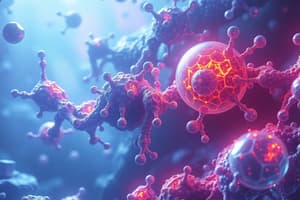Podcast
Questions and Answers
What happens to enzyme function when the pH is significantly lower or higher than the optimum pH?
What happens to enzyme function when the pH is significantly lower or higher than the optimum pH?
- Enzymatic function is lost due to disrupted tertiary structure. (correct)
- Tertiary structure is maintained.
- Enzymes exhibit increased substrate binding.
- Enzymes become more effective.
Which enzyme has the highest optimum pH for its activity?
Which enzyme has the highest optimum pH for its activity?
- Trypsin
- Pepsin
- Sucrase
- Arginase (correct)
What effect does increasing enzyme concentration have on the rate of reaction?
What effect does increasing enzyme concentration have on the rate of reaction?
- It has no effect on the rate of reaction.
- It only increases the rate of reaction if substrate concentration is also increased.
- It increases the rate of reaction until substrate saturation occurs. (correct)
- It decreases the rate of reaction.
What is the role of the end product in feedback control of metabolic pathways?
What is the role of the end product in feedback control of metabolic pathways?
Which of the following statements is true about zymogens?
Which of the following statements is true about zymogens?
What role do enzymes play in biological reactions?
What role do enzymes play in biological reactions?
What is the active site of an enzyme?
What is the active site of an enzyme?
Which model describes the flexibility of the active site adapting to the substrate?
Which model describes the flexibility of the active site adapting to the substrate?
Which of the following factors does NOT affect enzyme activity?
Which of the following factors does NOT affect enzyme activity?
What happens to enzymes at high temperatures?
What happens to enzymes at high temperatures?
What is the result of the enzyme-substrate complex formation?
What is the result of the enzyme-substrate complex formation?
What is a common naming convention for enzymes?
What is a common naming convention for enzymes?
Which statement is true regarding the lock-and-key model of enzyme action?
Which statement is true regarding the lock-and-key model of enzyme action?
Which of the following zymogens is activated in the stomach?
Which of the following zymogens is activated in the stomach?
What is the function of a kinase in enzyme regulation?
What is the function of a kinase in enzyme regulation?
Which enzyme is activated from its zymogen form proinsulin?
Which enzyme is activated from its zymogen form proinsulin?
Which of the following statements regarding cofactors is true?
Which of the following statements regarding cofactors is true?
What type of molecule is a coenzyme?
What type of molecule is a coenzyme?
How are fibrinogen and prothrombin activated?
How are fibrinogen and prothrombin activated?
What is the main role of vitamins in the body?
What is the main role of vitamins in the body?
What is the role of a phosphatase in enzyme regulation?
What is the role of a phosphatase in enzyme regulation?
Flashcards
What are enzymes?
What are enzymes?
Enzymes are biological catalysts that speed up chemical reactions without being consumed in the process.
What is the active site?
What is the active site?
The active site is a specific region on an enzyme where the substrate (the molecule the enzyme acts upon) binds.
What is the enzyme-substrate complex?
What is the enzyme-substrate complex?
The enzyme-substrate complex is the temporary association formed when the substrate binds to the active site of an enzyme.
Explain the induced-fit model.
Explain the induced-fit model.
Signup and view all the flashcards
What is enzyme activity?
What is enzyme activity?
Signup and view all the flashcards
How does temperature affect enzyme activity?
How does temperature affect enzyme activity?
Signup and view all the flashcards
How does pH affect enzyme activity?
How does pH affect enzyme activity?
Signup and view all the flashcards
What are the factors influencing enzyme activity?
What are the factors influencing enzyme activity?
Signup and view all the flashcards
Enzyme Optimal pH
Enzyme Optimal pH
Signup and view all the flashcards
Enzyme Activity and pH
Enzyme Activity and pH
Signup and view all the flashcards
Enzyme Concentration and Reaction Rate
Enzyme Concentration and Reaction Rate
Signup and view all the flashcards
Substrate Concentration and Reaction Rate
Substrate Concentration and Reaction Rate
Signup and view all the flashcards
Feedback Control in Metabolism
Feedback Control in Metabolism
Signup and view all the flashcards
Zymogen
Zymogen
Signup and view all the flashcards
Active Enzyme
Active Enzyme
Signup and view all the flashcards
Trypsinogen
Trypsinogen
Signup and view all the flashcards
Chymotrypsin
Chymotrypsin
Signup and view all the flashcards
Phosphorylation
Phosphorylation
Signup and view all the flashcards
Kinase
Kinase
Signup and view all the flashcards
Phosphatase
Phosphatase
Signup and view all the flashcards
Cofactor
Cofactor
Signup and view all the flashcards
Study Notes
Enzymes and Enzyme Action
- Enzymes are biological catalysts
- Increase the rate of a reaction
- Remain unchanged during the reaction
- Allow for faster conversion of reactants to products
Enzymes and Active Sites
- Active site is where the substrate fits for reactions to occur
- Substrate (e.g., lactose) is held in place by hydrogen bonds with amino acid R groups of the enzyme (e.g., lactase)
- Amino acids within the active site are crucial
Enzyme-Substrate Complex
- Active site of lactase is flexible to accommodate the substrate
- The reaction complex is complete when the disaccharide is hydrolyzed
- Monosaccharide products are released from the enzyme
- The enzyme is ready to bind another lactose molecule
Models of Enzyme Action
- Lock-and-key model: One enzyme fits one substrate
- Induced-fit model: More dynamic, flexible active site adapts to substrate shape to assist product formation and lower the activation energy, this is a more modern view of enzyme action.
Learning Check
- Active site is a section of the enzyme.
- In the induced-fit model, the enzyme's shape changes to fit the substrate.
Names of Enzymes
- Enzyme names typically end in -ase
- Enzyme names may indicate the reacting substance (e.g., sucrase for sucrose)
- Enzyme names may reflect the function (e.g., oxidases for oxidation)
- Common names for digestive enzymes exist (e.g., pepsin and trypsin)
Factors Affecting Enzyme Activity
- Enzyme activity is the speed of reaction catalysis
- Activity is heavily influenced by factors like temperature, pH and enzyme and substrate concentration
Enzyme Activity and Temperature
- Enzymes show peak activity at an optimum temperature.
- Low temperatures result in low enzymatic activity
- High temperatures cause denaturation and loss of activity
Enzyme Activity and pH
- Enzymes function best at an optimal pH.
- pH variations affect amino acid charges, impacting enzyme effectiveness
- Extreme pH values can disrupt the enzyme's tertiary structure and cause loss of function
Optimum pH values
- Enzymes in different organs (e.g., stomach, small intestine, liver) operate at specific pH values.
- Specific enzymes in the table are associated with their optimal pH values and their locations.
Enzyme Concentration
- Increasing enzyme concentration (at constant substrate concentration) increases the reaction rate
- More substrate binding to the enzyme occurs
Substrate Concentration
- Increasing substrate concentration (at constant enzyme concentration) increases the reaction rate.
- Enzyme eventually becomes saturated with substrate, reaching maximum activity
Feedback Control: Metabolism When Needed
- End product of a series of reactions acts as a negative regulator for the initial enzyme, stopping the reaction chain
- This process stops until the end product is no longer present to bind to the initial enzyme, then the reaction process restarts.
Zymogens: Proenzymes
- Large, inactive enzyme precursors are produced, activated when needed
- Examples include pepsinogen, trypsinogen, and others.
- The enzymes are produced in one location and then activated in another.
Enzyme Activity Regulation
- Kinase activates an inactive enzyme by adding a phosphate group (phosphorylation)
- Phosphatase activates an inactive enzyme by removing a phosphate group
Enzyme Cofactors
- Simple enzymes: Contain only protein
- Many enzymes require cofactors.
- Cofactors are small molecules such as metal ions or coenzymes.
- Coenzymes are organic molecules, often vitamins, that assist in enzyme function
- Table 20.9 shows enzymes that require metal ion cofactors.
Vitamins and Coenzymes
- Vitamins are organic molecules essential for health and growth
- Vitamins are needed in trace amounts
Water-Soluble Vitamins (B, C, H)
- Must be regularly replenished
- Not stored in the body, excess excreted
- Function as cofactors for enzymes
- Can be destroyed by heat (boiling)
Fat-Soluble Vitamins (A, D, E, K)
- Stored in the body
- Involved in vision, bone formation, antioxidants, and blood clotting.
- Not coenzymes for catalytic reactions
Studying That Suits You
Use AI to generate personalized quizzes and flashcards to suit your learning preferences.




